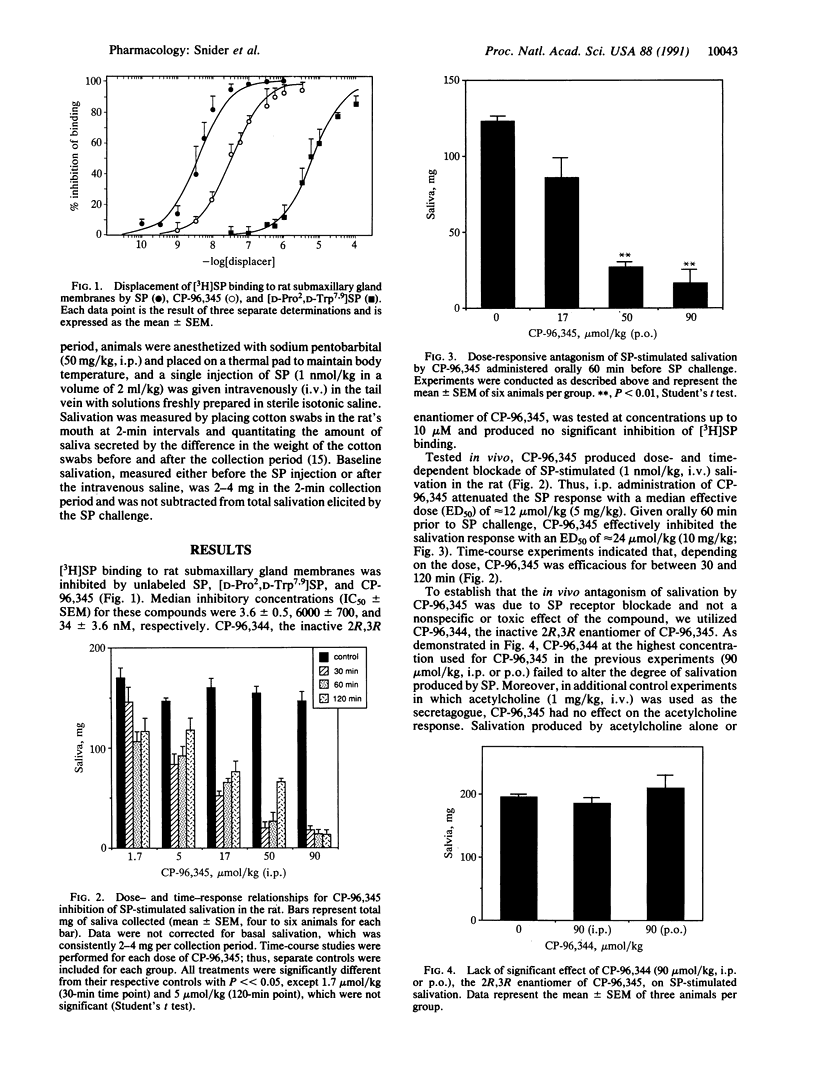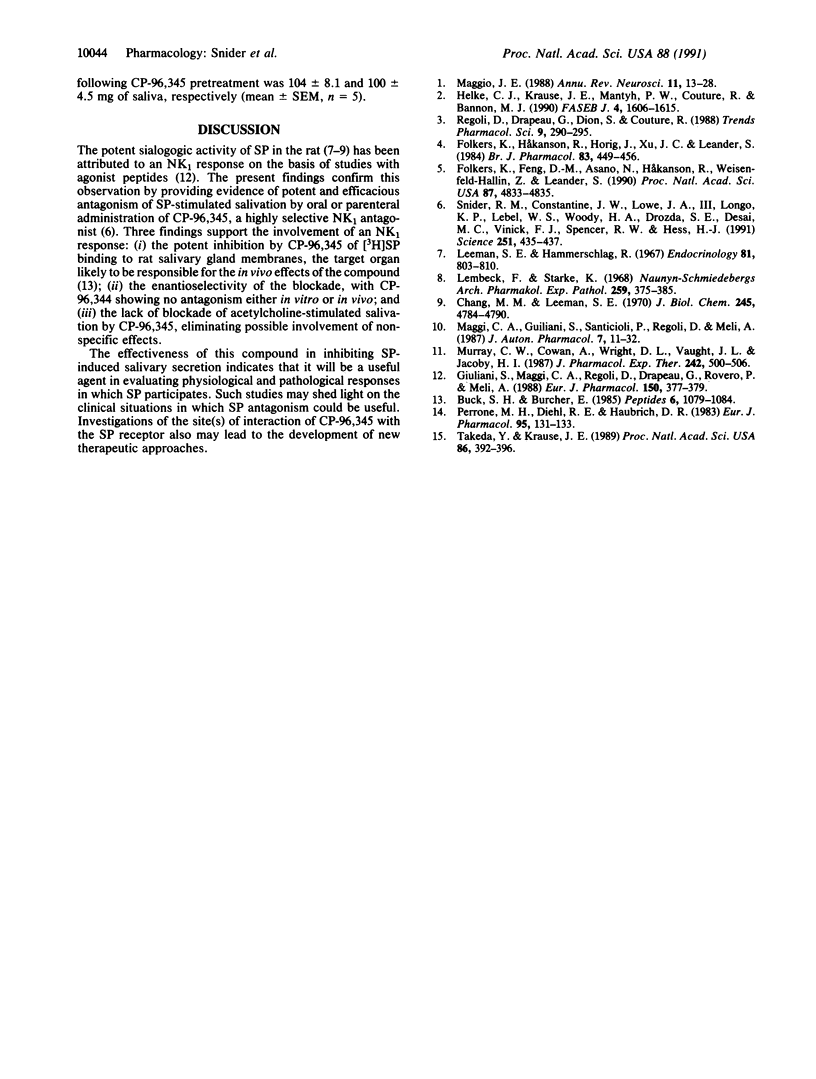Abstract
CP-96,345 [(2S,3S)-cis-2-(diphenylmethyl)-N-[(2-methoxyphenyl) methyl]-1-azabicyclo[2.2.2]octan-3-amine) antagonism of substance P-stimulated salivation was investigated in pentobarbital-anesthetized rats. Administered either intraperitoneally or orally, CP-96,345 produced dose-dependent inhibition of the sialogogic response elicited by substance P, with a median effective dose of 12-24 mumol/kg (5-10 mg/kg) of body weight, but had no effect on acetylcholine-stimulated salivation. CP-96,345 produced concentration-dependent inhibition of [3H]substance P binding to rat submaxillary gland membranes, with a median effective concentration of 34 +/- 3.6 nM. These biological activities were confined to CP-96,345 in that the 2R,3R enantiomer (CP-96,344) was without effect.
Full text
PDF


Selected References
These references are in PubMed. This may not be the complete list of references from this article.
- Buck S. H., Burcher E. The rat submaxillary gland contains predominantly P-type tachykinin binding sites. Peptides. 1985 Nov-Dec;6(6):1079–1084. doi: 10.1016/0196-9781(85)90431-0. [DOI] [PubMed] [Google Scholar]
- Chang M. M., Leeman S. E. Isolation of a sialogogic peptide from bovine hypothalamic tissue and its characterization as substance P. J Biol Chem. 1970 Sep 25;245(18):4784–4790. [PubMed] [Google Scholar]
- Folkers K., Feng D. M., Asano N., Håkanson R., Weisenfeld-Hallin Z., Leander S. Spantide II, an effective tachykinin antagonist having high potency and negligible neurotoxicity. Proc Natl Acad Sci U S A. 1990 Jun;87(12):4833–4835. doi: 10.1073/pnas.87.12.4833. [DOI] [PMC free article] [PubMed] [Google Scholar]
- Folkers K., Håkanson R., Hörig J., Xu J. C., Leander S. Biological evaluation of substance P antagonists. Br J Pharmacol. 1984 Oct;83(2):449–456. doi: 10.1111/j.1476-5381.1984.tb16506.x. [DOI] [PMC free article] [PubMed] [Google Scholar]
- Giuliani S., Maggi C. A., Regoli D., Drapeau G., Rovero P., Meli A. NK-1 receptors mediate the tachykinin stimulation of salivary secretion: selective agonists provide further evidence. Eur J Pharmacol. 1988 Jun 10;150(3):377–379. doi: 10.1016/0014-2999(88)90022-2. [DOI] [PubMed] [Google Scholar]
- Helke C. J., Krause J. E., Mantyh P. W., Couture R., Bannon M. J. Diversity in mammalian tachykinin peptidergic neurons: multiple peptides, receptors, and regulatory mechanisms. FASEB J. 1990 Apr 1;4(6):1606–1615. [PubMed] [Google Scholar]
- Leeman S. E., Hammerschlag R. Stimulation of salivary secretion by a factor extracted from hypothalamic tissue. Endocrinology. 1967 Oct;81(4):803–810. doi: 10.1210/endo-81-4-803. [DOI] [PubMed] [Google Scholar]
- Lembeck F., Starke K. Substanz P und Speichelsekretion. Naunyn Schmiedebergs Arch Exp Pathol Pharmakol. 1968;259(5):375–385. [PubMed] [Google Scholar]
- Maggi C. A., Giuliani S., Santicioli P., Regoli D., Meli A. Peripheral effects of neurokinins: functional evidence for the existence of multiple receptors. J Auton Pharmacol. 1987 Mar;7(1):11–32. doi: 10.1111/j.1474-8673.1987.tb00130.x. [DOI] [PubMed] [Google Scholar]
- Maggio J. E. Tachykinins. Annu Rev Neurosci. 1988;11:13–28. doi: 10.1146/annurev.ne.11.030188.000305. [DOI] [PubMed] [Google Scholar]
- Murray C. W., Cowan A., Wright D. L., Vaught J. L., Jacoby H. I. Neurokinin-induced salivation in the anesthetized rat: a three receptor hypothesis. J Pharmacol Exp Ther. 1987 Aug;242(2):500–506. [PubMed] [Google Scholar]
- Perrone M. H., Diehl R. E., Haubrich D. R. Binding of [3H]substance P to putative substance P receptors in rat brain membranes. Eur J Pharmacol. 1983 Nov 11;95(1-2):131–133. doi: 10.1016/0014-2999(83)90277-7. [DOI] [PubMed] [Google Scholar]
- Regoli D., Drapeau G., Dion S., Couture R. New selective agonists for neurokinin receptors: pharmacological tools for receptor characterization. Trends Pharmacol Sci. 1988 Aug;9(8):290–295. doi: 10.1016/0165-6147(88)90013-2. [DOI] [PubMed] [Google Scholar]
- Snider R. M., Constantine J. W., Lowe J. A., 3rd, Longo K. P., Lebel W. S., Woody H. A., Drozda S. E., Desai M. C., Vinick F. J., Spencer R. W. A potent nonpeptide antagonist of the substance P (NK1) receptor. Science. 1991 Jan 25;251(4992):435–437. doi: 10.1126/science.1703323. [DOI] [PubMed] [Google Scholar]
- Takeda Y., Krause J. E. Neuropeptide K potently stimulates salivary gland secretion and potentiates substance P-induced salivation. Proc Natl Acad Sci U S A. 1989 Jan;86(1):392–396. doi: 10.1073/pnas.86.1.392. [DOI] [PMC free article] [PubMed] [Google Scholar]


